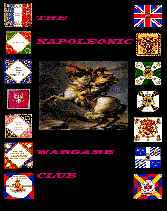

Napoleonic Wargame Club
Newsletter
| Edition 8 | November 1999 |
Publisher: Pierre Desruisseaux, Secretary of State
Editor: Ken Jones, British Army
Associate Editor: Chris Wattie, British Army
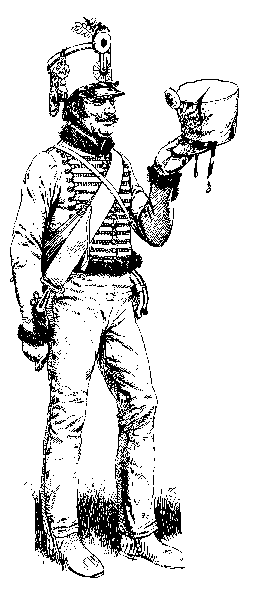
In this Issue ...
Dear Members:
Welcome to the November 1999 edition of the NWC's newsletter. Despite some wayward (or well-aimed) 12-lb roundshot that slightly damaged the presses, we have managed to meet our quarterly schedule (February, May, August, November). The newsletter continues to evolve. Please bear with us as we learn our way along. Hopefully, future issues will sport a more refined and professional look and feel. Many thanks to all those members who contributed articles, letters, dispatches, army news, pictures, etc. to the newsletter and helped make this happen. A special thanks to Jeff Bardon, Charles Upton, and Rob Hamper who submitted this edition's feature articles . We hope to make Rob's "Grapeshot" column a regular feature. Many thanks also to Herr Hofschröer for sharing with us his knowledge and unique insights into the 1815 campaign.
There have been more than a few changes in the club since last we talked. The Allied-Coalition Armies underwent a major reorganization in which all officers had an opportunity to choose new commands. The Coalition forces were also bolstered by the addition of the Austrian Army under the command of Field Marshall Bill Peters. Talk about change, the French and British now boast their own navies! Yes, its true. FLM Bill Peters donned the uniform of a midshipman and spearheaded the effort to establish the club's new naval forces. Indeed, it has been much fun to watch some of our members jump from the saddle and onto the quarterdeck to engage in some real time naval action with Talonsoft's Age of Sail game. The naval branch is completely separate from the land forces, however, and officers may hold separate ranks in each.
According to Coalition Army HQ, there are 155 officers on the active rolls (76 Allied, 2 Austrian, 44 Prussian, 33 Russian). Over on the French side, the Commander-in-Chief reports 209 active officers on the Grande Armee rolls (106 in l'Armee du Nord and 99 in l'Armee du Rhine and 4 unattached). [Editors note: This tally differs from my count on the AdR website which shows 96 officers including the instructors and cadets in the Ecole de Mars, and the tally submitted by the Commander of the AdN which lists only 76 officers on the active rolls.] Impressive numbers. Nevertheless, the recruiting sergeants for both sides continue to roam the countryside in search of new recruits. In fact, rumor has it that the Austrians are paying bounties to current officers for steering new recruits to their enlistment center.
How goes the war you ask? According to end game reports both sides appear to be pretty evenly matched. In the month of September, the French held a slight victory point advantage (43 to 40) with 21 major victories in the month and 1 minor victory versus the Allied Coalition's 18 major victories and 4 minors (British 12maj/1min, Prussians 1maj/1min, Russians 5 maj/1min). There were also 7 draws during September. But the advantage was reversed in October as the Allied Armies recorded 14 major wins and 1 minor (VP=29) versus the Grande Armee's 10 major victories and 2 minors (VP=22). There were also 4 draws in October. Well played gentlemen, well played indeed!
In the meantime, there are plenty of battles to be fought. Enjoy the camaraderie, keep your honor intact, and remember to remove the ramrod from your musket before you fire. Oh, and don't ignore your families; or at least ply them with some of that captured gold, jewelry, or other trinkets in compensation for those hours spent on the virtual battlefield.
Your Humble and Obedient Servant,
K. Jones, Editor
Strategy and Tactics | Dispatches | Front and Center | On the Internet | Letters to the Editor
It makes no difference what men think of war, said the judge. War endures. As well ask men what they think of stone. War was always here. Before man was, war waited for him. The ultimate trade awaiting the ultimate practitioner.
Cormac McCarthy, Blood Meridian
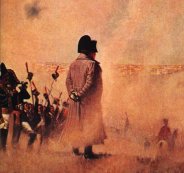
The Ultimate Practitioner?
In this Issue ...
(this link will take you out of the NWC newsletter; click BACK to return here)
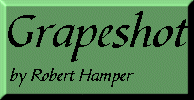

with Peter Hofschröer
Welcome to the first installment of Grapeshot where we fire a bunch of questions at our guest and see what turns up. Our first unfortunate target is Mr. Peter Hofschröer, a man well known in wargaming and Napoleonic history circles. He is renowned for his in-depth study of the Prussian/German side of events during the wars against Imperial France and for his cutting edge analysis of these times. Mr. Hofschröer dares to be different.
Mr. Hofschröer's published works include a two volume account of the Waterloo Campaign (the second of which was released in October, 1999); volumes in the Osprey Men-at-Arms series on the Prussian and Hanoverian Napoleonic Armies; an analysis of the Leipzig-1813 battle for the Osprey Campaign series, as well as numerous articles in various academic and hobby magazines.
Welcome sir, we'll start with a little background on yourself.
I was born on the 28th of May, 1956 in London, England. I attended King's College,
University of London, where I received a Bachelor of Arts (Honours) in German and History.
King's had, at that time, Britain's leading War Studies Department. I currently reside in
Rottenmann, Austria.
When did you first become interested in military history?
Ever since I can remember, I always have been.
Do you have interests in other eras of military history besides the Napoleonic one?
Frederick and Bismarck.
Which is your favourite and why?
Bismarck. The combination of modern weapons with the colourful uniforms of earlier periods
is an interesting combination.
Do you frequent any historical discussion groups on the Internet?
Several, particularly the Napoleon Series.
I understand you helped in the design of a wargame for the computer, could you tell
us a bit about that?
I didn't design the game. I merely provided historical information for MicroProse's
"Fields of Glory". In its time, it was a revolutionary product.
Are you currently involved in any similar projects? If not, would you like another
opportunity to provide historical assistance for another computer game?
No. I would happily provide historical assistance for another computer game.
Do you wargame yourself? If so, could you tell us about the extent of your interests
here?
I stopped years ago. You can see my wargames army on display in the Blücher Museum in
Kaub on the Rhine.
What surprises you most about wargamers in general?
I have not been in touch with the wargaming community for so long that I cannot comment.
(Interviewer's Note: I asked Mr. Hofschröer several questions on wargaming, but since
he was no longer in those circles, he felt he could not adequately answer them. I have
omitted them to avoid repetition and to save space. Mr. Hofschröer if you are curious
about computer wargaming, drop me a note!)
You have often stated to the effect that Anglo-historians perpetuate myths about the
Waterloo campaign by re-hashing second and third party sources that don't quite have the
whole picture. Name three of the foremost English language authorities on this subject.
William Siborne was the one and only British historian ever to conduct original research
into the Waterloo Campaign and his writings were based in part on primary sources.
Chesney's analysis of the Campaign was remarkable in its attempt at objectivity. I cannot
think of any other British works on the subject that meet those two criteria - solid
research and objectivity.
How about non-anglophone authors? (ex. German/ French/ Dutch/ Belgian/ Russian)
Pflugk-Harttung exhausted the German archives. Charras wrote the first authoritative
French account of the campaign, although it was published in Belgium. He did not make
himself popular at home, as Waterloo remained a sensitive subject in France for decades
afterwards. De Bas and T'Serclaes de Wommersom based their work largely on the Netherlands
archives. I know of no Russian work on the campaign.
What would be the best, if any, German sources translated into English that are
available to would-be scholars of the Napoleonic period?
Some of Clausewitz's work, although that suffered from having been published posthumously.
Had the famous solider-philosopher himself read the manuscripts, I am sure he would have
made some alterations. Müffling's memoirs, though these are unreliable in places. His
memory was rather selective when it came to his own errors. The best works - the general
staff histories of these campaigns - have never been translated. That is a shame because
these works are of the highest standards.
You have done so much archival research from sources that, until recently, were
largely ignored or overlooked. Do you feel there may yet be a wealth of data that remains
untapped, say in archives of former East-bloc nations?
Ironically, one of the main untapped sources of archive material on the subject is that in
Britain. Thanks to the Royal Commission for Historical Manuscripts and the National
Register of Archives, it is possible for the historian to locate all known papers via the
internet. There is a substantial amount of unused material that British Waterloo
historians have never used and it is so easy to locate. Instead, we just get a
regurgitation of selected myths, often with new embellishments. This contrasts with the
Prussian War Archives, which are missing, presumed destroyed in World War 2. Thanks to
their extensive use and direct quotation in works such as those by Pflugk-Harttung and
others, it has been possible for me to reconstruct a substantial part of this missing
material. Incidentally, rumour has it that the larger part of the Prussian War Archives
survived 1945 and is currently held in the former KGB archive in Moscow, but nobody is
admitting this yet.
In your recently published books you lay out the evidence that the Duke of
Wellington actively deceived Blücher and the Prussians. At what point in your studies did
you formulate this theory, that is, what inspired you to look deeper into this question?
I was aware that a number of German historians had made this accusation a century ago.
When I began my researches, I considered their charges to be flavoured by the politics of
that period. However, on checking the papers of Sir Hudson Lowe, for a time Wellington's
quartermaster-general (chief-of-staff) in 1815, by coincidence, I found several documents
that indicated he was not convinced by the version of certain events as given by
Wellington. Pursuing that line of research added several years of work to this project and
took me to archives and private homes, particularly in Britain. Here, I found a number of
significant items that corroborated the charges made a century ago. The accusations made
then by those German historians, as it turns out, were fairly mild. The full extent of
Wellington's attempts at manipulating the record to cover his own errors has yet to be
told. My books mention only one or two instances.
So, Wellington, in your assertions, is more guilty of what he didn't tell Blucher
then in what he had already promised?
To an extent, yes. However, let us not forget that Wellington deliberately misled
Blücher, Müffling and the Prince of Orange as to his intentions on the morning of 16
June 1815. For instance, several times Wellington claimed he was moving a substantial part
of his army to Quatre Bras. The fact of the matter is that, other than part of the
Reserve, he issued no orders for any further troops to move to that point until after the
fighting had started. In fact, had the Prince of Orange not been so alert and ordered up
certain divisions himself while Wellington was away at the meeting at Brye with Blücher,
then the chances are that Ney would have overwhelmed Quatre Bras very quickly.
Were there any major surprises that arose as you gathered materials for this
project?
The biggest surprise was locating the manuscript of a translation into English of
Clausewitz's History of the 1815 Campaign. I was aware that the Earl of Ellesmere,
a close associate of Wellington, had translated Clausewitz's 1812, and I always
wondered why he did not translate the 1815 volume as well. When checking some other papers
in the unpublished Wellington Papers, I found the manuscript of the translation of
Clausewitz's 1815. Wellington disapproved of parts of Clausewitz's writings - he
was particularly sensitive about the issue of his broken promises of support made to
Blücher. He made his disapproval known to his associates and they discretely dropped the
issue. The manuscript was never published and Wellington, in effect, ensured that it did
not see the light of day.
Do you think Clausewitz's 1815 will ever be published in English?
Clausewitz's 1815 will be published in English in the next couple of years. Dr. Gregory
Pedlow, SHAPE's official historian based in Mons, Belgium, near Waterloo, is working on
the translation and Dr. Christopher Bassford, a Clausewitz specialist, is editing the
text. I have assisted this project by supplying part of the correspondence on this issue
between Wellington and certain of his associates from my files.
Is it your assertion that Wellington willingly wanted the French blows to fall first
upon the Prussians or was his supposed deception a cover up for his misjudgments?
The balance of the evidence indicates that Wellington did not deliberately intend leaving
Blücher in the lurch. However, for reasons we can only largely speculate at today,
Wellington did not react to the news of the outbreak of hostilities on 15 June 1815 as
quickly as he should have done. Wellington misled Blücher as to his positions and
intentions to buy back the lost time. When he started to mislead Blücher, putting him in
danger off facing a substantial part of Napoleon's forces with little or no support from
Wellington, he did so in the knowledge that Blücher had ordered all four of his army
corps to concentrate in the Sombreffe position. It was only the next afternoon at the
meeting at Brye near Ligny that Wellington heard Bülow would not be arriving. The battle
was just about to start and by then it was too late for Wellington to go back on what he
had said.
Obviously you have been subjected to vehement attacks from Wellington supporters.
What is your biggest argument with them, that is, what vital bit of information do you
suppose they are ignoring that would invalidate their claims?
Wellington's supporters have been conducting a smear campaign against my person and my
writings. They have not been able to refute a single point of my case. Instead they have
deliberately misrepresented it. I find it ironic that those attempting to defend their
great hero against charges of duplicity and deceit do so by being duplicitous and
deceitful themselves. Sadly, they are the last people to realize that they have done more
to undermine the reputation of their great hero than anything I have ever written. They
have deliberately ignored the entire body of significant documentary evidence I have
produced. I suspect this is because this evidence is so overwhelming that a plausible
counter-argument is not possible. Instead, we have had a display of hysterics.
You have quoted yourself as "having an axe to grind" like other
author-historians that write along national lines. Is it possible that your arguments are
slightly biased, thereby bringing a sort of patriotic balance to the whole picture?
I am the first to say that my work is not balanced. I have never claimed it is. I am
telling the other side of the story and hoping that my one tome will go some way to
correcting the false impressions made by British writers over the best part of two hundred
years.
What is your feel for the German people's appreciation of their 18th and 19th
century heritage?
Germans today are taught that they only have twelve years of history, that they must be
ashamed about it and that every person coming along with a story - even those that are
implausible - about how their family suffered in that time, must be given sympathy and
preferably money. The rest of German history is largely ignored. There are a number of
cases of good historians that have been persecuted for not toeing the line and being
politically correct.
What is your next topic going to be? Do you have any more Napoleonic topics that
would like to research?
I am currently working on an Osprey Campaign on Lützen/1813. The project I am currently
planning has the working title "Waterloogate - How Wellington Manipulated the
Record". You think my work on the subject to date has been controversial? I have
saved the best parts for last!
(Interviewer's note: Ouch! Can't wait for that one!)
Thank you Mr. Hofschröer for your time and patience. Perhaps we can visit with you again when your next works are published?
That concludes the first edition of Grapeshot for the Napoleonic Wargaming Club Newsletter. I hope you found it an enjoyable and intriguing read. Although the Editor has not decided on publishing feedback on this article, send some in anyway and if there's something we feel would merit our reader's interest perhaps we can coax him into publishing it! Who will be our next target for the Grapeshot volley? Ahhhh, that's a secret not even Ocampo's Cossacks will find out!
Updated 15/11/99
The Front Page | Feature Articles | Dispatches | Front and Center | On the Internet | Letters to the Editor
harges of cavalry are equally useful at the beginning, the middle, and the end of a battle. They should be made always, if possible, on the flanks of the infantry, especially when the last is engaged in front.C
Napoleon's Maxim of War L

Who Are These Guys?
In this Issue ...



On the Use of Combined Arms in Battleground Games
By : General de Brigade Jeff Bardon, l'Armee du Nord
Remember the old children's game, "Rock-Scissors-Paper", where at the count of three you'd thrust out your hand indicating your choice and shouting, "Rock beats scissors! I win!" Each of the three choices had a counter, something that could defeat it if it was alone. Choosing the rock left you vulnerable to the paper, which in turn could be cut by the scissors, which could be smashed by the rock. Employed alone each element of the Napoleonic army can achieve victory, but only at great risk and even greater luck. Your opponent must fail to guard against your assault and allow you to win. With the increase in training and the abundance of manuals available for study, counting on luck is no longer a successful strategy. All arms: Infantry, Cavalry, and Artillery must be combined with maneuver to dislodge and rout your opponent.
The following examples illustrate the truth behind the maxim, "Infantry, cavalry and artillery are nothing without each other..."
Example 1: Overexuberance and overconfidence at Waterloo
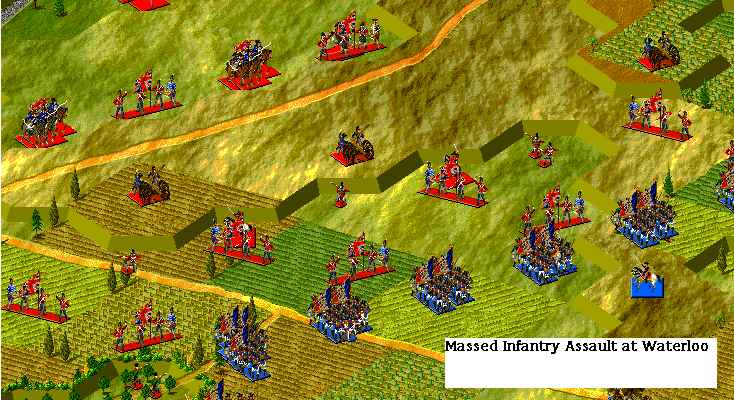
The French columns have pushed back the British skirmishers and cresting the hill reveals the enemy in extended line in front of the forward batteries. Bachelu and Foy's divisions form up in a massive assault. It's an urge we've all felt, a massed infantry assault to quickly and decisively break the enemy line and seize a position, in this case the Mt. St. Jean ridge. The columns will only be under the enemy guns for a turn or two, too long to set up a battery. The opportunity to disorder and eventually destroy the enemy guards is simply too good to pass up.
Well, you can imagine the results....
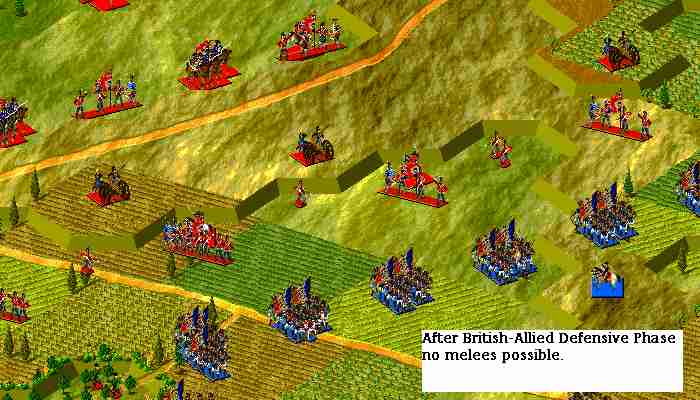
The artillery batteries on the ridge caused fatigue and casualties on the tightly packed columns. The front ranks of the British elite Foot Guards poured in lethal volleys before retiring on their reserve. The French columns are now exposed, too far away to bring the enemy to the bayonet. The optimistic assessment of one or two turns is now three. And the aftermath, General de Brigade Gauthier killed, General de Brigade Campi wounded and 1,000 French casualties against 125 British casualties.
Before you needlessly sacrifice a brigade, consider the options. The BGW provides the attacker with one key advantage, INITIATIVE. The defender must react to the threat. In the above example, the massed infantry was only a minor threat to the British line, easily countered by changing from extended line to regular formation. The British defense proved a far greater threat than the French attack, taking advantage of bonuses for fire directed at columns, +50% for artillery and +25% for infantry, as well as +50% for infantry firing in 2-rank lines.
The British line represents a combined arms defense. Infantry positioned to the front protects the guns, while the artillery discourages enemy assaults. Behind the reverse slope are reserves. Cavalry and horse artillery stand prepared to sweep the ridge clear should any French assault succeed in reach its crest.
Assaulting this position requires combined arms. Against the same line, bring forward your skirmish line to harass the enemy front, supported by battalions in line formation. Units that move suffer a 50% reduction in their fire in the offensive phase. You won't inflict large numbers of casualties, but you will threaten the infantry. Leave one hex gaps between your battalions to provide room for cavalry to charge, a larger threat. Finally, bring guns up on the ridge opposite the enemy battery. They may not be able to fire this round but their presence is a third threat.
Example 2: Combined Arms
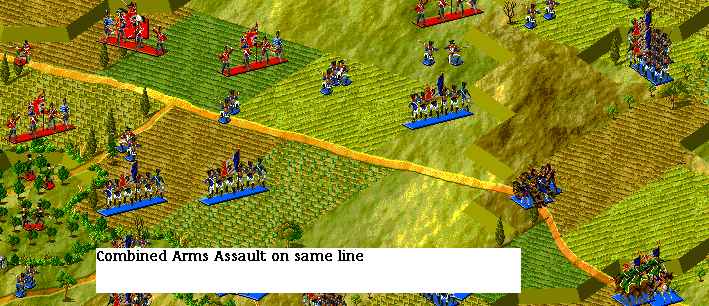
After crossing the ridge spur northeast of Hougomont, the French commander brings forward guns and cavalry support to threaten the enemy line. The British decide to remain in position and guard the guns. On the following turn, the foot batteries are supplemented by horse batteries that were hidden behind the reverse slope; thus giving the French twice as many batteries in position. The British line now faces a threat from each arm. What will they do?
The attacker has now put the defender in a difficult situation. In this example, I left the infantry in place. They could have withdrawn behind the reverse slope, but that would leave the guns vulnerable to sweeping cavalry or massed infantry assaults (as often happens in Waterloo battles in the NWC). Withdrawal is as good as giving up on the guns.
Against the combined threats, holding position is not much better. A cavalry charge by the French could still reach the guns and inflict losses on the Guards infantry in the process. Forming squares would protect the guns, but each would almost certainly be disordered by cannon fire and musketry. Any defending unit that suffers casualties in the offensive phase will be disordered the next movement phase (or possibly rout for lower quality troops). A good tactic against extended lines is to disorder both sections with artillery and musket fire. This leaves them stuck in line formation and vulnerable to assault and melee on succeeding turns.
Regardless, the tactical advantage lies with the French. Why? They still hold the ridge, and our forces are no closer to the top of the hill. Because this is a battle of maneuver, the decisive action does not happen on the first turn of contact. The enemy front is now disordered and cannot retreat behind the slope in less than 2 turns. They are now exposed to four rounds of artillery fire from the massed French battery safely out of range of an enemy charge. True, you are no closer to the objective hex, but tactically the cream of the enemy army is isolated by a demonstration in force, allowing other units to move up under cover of the terrain and around the flanks. The combining of the three branches of arms gives the attacker this advantage.



By Charles Upton, Lt. Colonel, 3rd Hussars,
KGLHaving, as a Prussian been caught out at Ligny, and having read harassing accounts in the Rhine Tavern of a horrible fate meted out to the Prussians at Ligny, I decided to research why the game should be so different from the actual battle. The reports of the battle note that Blucher was not beaten but retreated from the field in good order. Indeed the Prussians were only finally driven out of Ligny at twilight - and then by the Guard!
The initial search was for a detailed contemporary map which might give some insight particularly to the feature identified as a creek by TalonSoft and therefore impassable except on bridges. Incidentally on the bitmap, the stream doesn't appear visually to change when passing near St. Amand la Haye except to the banks being boggy, yet the "terrain" map behind it has changed it to a one-stride-over ditch - a very different thing.
With the stream in and around Ligny being impassable, many of the Prussian troops, particularly the fixed units, are doomed to destruction as they are trapped against the water course. This disadvantage to the Prussians would seem to be offset by the stream being a natural barrier to the French - who similarly can only cross on the bridges. However, the latter doesn't help if the Prussians have either lost a lot of men by having the bridges "blocked" by their guarding units, or they have no bridge defense units - having left the bridges open to let their own fleeing troops through. On the other hand, why are the initial troop placements in the St. Amand area of similar ilk to those around Ligny (albeit thinner on the ground) if the river/stream/creek was not a similar feature to that at Ligny?
My first port of call was that excellent SPI board game - "Napoleon's last battles", where the map shows the whole course of the stream (through Ligny and beyond St. Amand) as being the same "barrier"; that is, it can be crossed with a 2 MP penalty and it adds to the defense if attacking across it. SPI maintain that they evolved the maps from several visits to the New York Public Library's map division. This differs from TalonSoft in two vital aspects:
One- that the water course is the same size feature or has the same effect to movement along its whole course. Two- that it is passable - with an effect to movement.
Not wanting to rely only on SPI's interpretation, I continued my search. I was unable to find any contemporary or current maps that gave any indication to the true nature of the water course. However I did come upon Captain W. Siborne's "History of the Waterloo Campaign", which gives the most thorough account I have yet read of the whole campaign. I have run into Capt. Siborne before - having been lucky enough to see the model he made of the battlefield at Waterloo (built in 1840) at the Army museum in Chelsea, but I didn't realize he had written such a treasure house of information. - He was in Wellington's Army, so walked a lot of the ground, and then obtained many eye-witness accounts in order to write his book, so I would count it as reliable an account as can be obtained.
The first finding in his description of "The position of Ligny" is "The position itself comprises the heights of Bry, Sombref and Tongrines....These heights are bounded on the south-west and western sides, or right of the position, by a ravine through which winds a small rivulet along the villages of Wagnele, St Amand-la-Haye and St.Amand, near the lower end of which last, it unites with the greater rivulet of the Ligny; and along the south side by a valley through which flows the Ligny..... At Vilrets another small rivulet falls into the Ligny on quitting a deep ravine, which commences north of the village of Botey, and thus tends to the security of the extreme left of the position"

Immediately my eye was taken by the use of rivulet as a description - hardly a description of an impassable water barrier; admittedly he does mention greater rivulet, but it is still not graced with a term descriptive of an impassable stream. In another book I had a picture of the stream that runs through Genappe (north of QB). This looks like a stream in a deep ravine to me (remember a ravine in the low lying areas of Belgium !). Unfortunately Siborne does not mention the size of this feature but does say of the Allied retreat from QB "To facilitate the passage of other portions of the army through the narrow defile of the bridge and town of Genappe this (Alten's) division retired by Bezy, and crossed the Genappe by the bridge lower down the stream." and later "This right column (cavalry) was to pass the Genappe by the ford higher up the stream than the town". Obviously a barrier only to be crossed by bridges when one is making an orderly passage. It looks to me to be quite passable by infantry but not by other troops. However there is no comparison between the water courses except that he notes that the army used the bridges or fords exclusively.
I think I found the key to the extent of "impassability" of the rivulet in the descriptions of the fighting around Ligny.
@8:30pm "Napoleon arrived near Ligny with 8 battalions of the guard, Milhaud's corps of heavy cavalry (8 regiments of cuirassiers and the grenadiers a cheval of the guard)" - all quite fresh. "Several batteries of the guard opened a destructive fire upon the Prussians posted within and formed in the immediate rear of Ligny." Thus at this point the Prussians were still in possession of Ligny. "The Prussians on seeing the columns advance, confined their operations to securing an orderly retreat for the defenders. Milhaud's whole corps had entered on the other side of the village. The Prussian infantry were compelled to evacuate Ligny and effected its retreat in squares, in perfect order. To ease the pressure Blucher ordered cavalry forward and they attempted to disrupt the French infantry."
I can only conclude from this that the rivulet of the Ligny is NO barrier to orderly movement. From the description (I have paraphrased the complete description) the Prussians were in Ligny and formed behind it then retreated in orderly squares - which cannot have been across bridges nor yet across an impassable rivulet. Nor yet could the Prussian cavalry have counter charged across the stream if only passable on bridges. It could however have been across a small stream which was no impediment to movement.
If however the Prussians were already at that time in the part of the village behind the stream, by the same argument this number of infantry columns and cavalry could not have crossed bridges in good order, so must have crossed a stream, and in the case of cavalry an insignificant stream in order to be able to threaten the Prussian infantry.
My conclusion is that the TalonSoft terrain map is incorrect and that the stream is of the same order of barrier along its whole length, and that this barrier is not a prohibition to movement - only an extra element.
The effect of this on the game results is known - as cited in the first paragraph. The effect of correcting this misrepresentation of the terrain on the game is unknown. The Prussians would loose the natural barrier, which would seem to favour the French. However they would be less likely to loose large numbers of troops in the early stages, and would be able to easily reinforce the better natural cover of the buildings. These troops would be exposed to French artillery whilst coming up, but that is a hazard of the unsuitable Prussian position. Does anyone know how to edit the terrain map? I would like to play a game with the terrain in its original state.
Of course at the same time, I might like the Prussian troops, particularly the Landwehr and skirmishers to have a more realistic quality. Sibourne says "It was in this critical period of the battle, that the 2nd battalion of the 1st Westphalian landwehr under the command of Capt. Gillnhaussen appeared upon the front where it particularly distinguished itself. In the first place it succeeded in effectively checking the French cuirassiers, who were in pursuit of the infantry.. Then it drove back French cavalry which was on the point of making a fresh attack. Afterwards it successfully withstood three charges by French cavalry of the guard." - but that is the subject for another time.
Lt. Col. Charles Upton 3rd KGL Hussars
Editor's Choice: From the Web:
Eyewitness Account: French Tactics in 1807
The Front Page | Feature Articles | Strategy and Tactics | Front and Center | On the Internet | Letters to the Editor
T
o act upon lines far removed from each other, and without communications, is to commit a fault which always gives birth to a second.Napoleon's Maxim of War XI
Allied Coalition News | British Army | La Grande Army | Prussian Army | Russian Army
Austria Joins the War!
This month the Austrians maneuvered brilliantly to enter the Coalition against the wishes of the French usurper, Bonaparte. Minister Metternich wisely held his men out of the war until he felt that the interests of all Europe were in danger! Now General Schwartzenberg rides confidently at the head of his army to take the fight to the French!
View the new Austrian army parade ground at:
http://www.geocities.com/Yosemite/Falls/7154/austrianhq.html
Allied Recruitment Month
Any Allied member that recruits a new member for ANY Allied army during the month of November will be given 5 points. Why not fill out the form for your new recruit to help get them started? I previously had posted that I would pay out 10 points for new Austrian recruits but I would prefer not to lure folks to put their friends in a foreign army!
Editors Note: Due to the date of the newsletter's release, perhaps the bounty could be extended to year end. Bill?
Club Members are NOW Sailing!
In October a Naval branch was added to the NWC. Immediately the ranks swelled with members new and old! Currently we have 2 navies in the club a French and British navy but as we gain more members rules governing the creation of new navies will allow for a Spanish, Russian, US, Turkish, Danish or Dutch fleet not to mention any that we can create using existing ships from the Age of Sail game.
See the new Navy Branch at:
http://erik-frederiksen.tripod.com/navy_main.html
Sign up with the British Navy at:
http://www.geocities.com/Yosemite/Falls/7154/britnavy.html
New Allied CiC
In October Gen. Pierre Desruisseaux handed over the sword of the Allied Coalition to me. All of the officers should give a hearty cheer for our departing commander! I call on all of our officers to roundly stomp the French!
Bill Peters
FML Bill Peters
Allied Coalition CiC
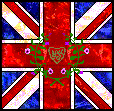
Ladies and Gentlemen:
This has been a busy time for my tireless and invaluable staff at British Army Headquarters. The army web site has been changed and the brigades, divisions and corps reassigned. The regiments assigned to each brigade are now almost identical to their historical dispositions and shall remain fixed, even as officers come and go through promotion or retirement. In short, we hope there will be no further all-encompassing reorganizations. Those officers who had slipped into inactivity have now been weeded out of our ranks by the simple expedient of requiring serving officers to re-apply for command of their regiments. Although our ranks are as a result thinner, we are assured of the energy and enthusiasm, not to mention the skill, of those still among us. Our congratulations to newly posted corps commanders Col. Rodrigo Leon and Col. (b) Tony Dobson and to all of the new division and brigade commanders. Special thanks and a round of double brandies in the mess to Brig-Gen Sir Paul Harris for his Herculean efforts during the reorganization and also to Brig-Gen Sir Christopher Wattie. Any officers who have not yet asked for a new assignment should contact Brig.-Gen. Harris post haste.
Our ranks are being swelled daily by a crop of recruits whose tactical skills are dazzling the instructors of the Royal Military Academy, while our veterans continue to acquit themselves with honour on the field.
God Save the King!
Lord Arthur Wellesley
British Army Commander
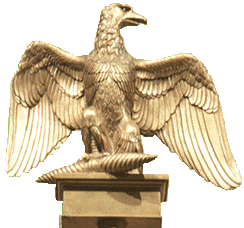
La Grande Armee
The Presentation of the Eagle
Soldiers, there are your colours. These eagles will serve you as points for rallying. They will be everywhere your Emperor judges necessary for the defense of his throne and his people. You will swear to give your life to defend him and to constantly to uphold them by your courage on your way to victory.
L'Armee du Rhine
SEE FRONT AND CENTER
Ecole de Mars
The Ecole de Mars is the official training center for the L'Armee du Rhine. All recruits who join the AdR forces must pass through the doors of the Ecole. There are now 12 staff members and 32 active cadets. To date 19 officers have graduated from the Ecole de Mars. Additionally, a new award was recently added. It is called the Honor Sabre. Certain criteria has been set and can be reviewed at: (
http://www.geocities.com/TimesSquare/Battlefield/9703/hs.html).This is an award we hope all cadets will strive to receive.
The Ecole's main page is at (
http://www.geocities.com/TimesSquare/Battlefield/9703/) . All visitors are welcome, but must check the weapons at the door.Anyone with both HTML experience and that speaks either French, Spanish or German please contact the Commandant of the Ecole de Mars to possibly assist in a project.
Respectfully,
Gen. de Brig. Richard Hamilton
Commandant, Ecole de Mars
l'Armee du Rhine'
L'Armee du Nord
Dear Members: I respectfully submit the following report on the current status of the Armee du Nord:
I Corps -- Under Gen. Mitchell's able guidance, the I Corps' command structure is now coming together again. The new commanders are: Capt. Stuart Wilson (CO - 1st Div), Chef de Bn. Ian Weightman (CO -1ere Bg/2eme Dv), Capt. Ian Coser (1ere Bg/1ere DCL) and Chef d'Escadron Fabio Fogato (CO - Artillerie de Reserve). Col. Chris Sloan is now serving in the dual capacity of CO - 1ere DCL and Aide de Camp to Gen. Mitchell and has revamped the AdN's Home page and IC's OOB. Current strength: 7 commanders and 17 rank & file. Total: 24. The new AdN Home Page is at:
http://www.angelfire.com/ab2/armeedunord/index.html
II Corps -- Special mention should be made of Col. Chuck Jensen's gracious acceptance of the post of Chief of Staff, in addition to his duties as commander of the 6eme Dv de Inf, to ease the administrative burden on Gen. Masson. The members have been quite active and the principal promotions and awards are noted below. Current strength: 4 commanders and 20 rank & file. Total: 24
IIIC - Since the last muster there have been no significant new developments within the III Corps de Armee. Current strength stands at 8 commanders and 20 rank and file.
Your Humble Servant,
Gen. M. Francisco Palomo
Gen. de Dv. M. Francisco Palomo
Count de Massena
CoA, AdN
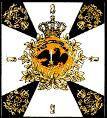
New Recruits
Departures
GL Bill Peters has departed the ranks of the Prussian Army to form the Austrian Army and to kickstart the Naval Arm of the NWC. Bill continues to expand the horizons of the club, making it a better place to game and relive history. We wish him well.
Other officers have left our ranks due to personal commitments. We hope to see them again one day.
Some officers had to be deleted for failure to communicate with the Army Staff. The General Staff would like to remind officers that it is imperative to communicate with your commanding officer at least once a month, even if you are not currently involved in any games. The Staff expends much energy on keeping track of all it's officers and this communication helps greatly.
Returns
The Prussian Army greets once more it's "Saxon" officer, Sam Orlando who spent a short stint with the French Army. Herr Orlando, after much soul searching, realized the best hopes of his people lay with the Prussian Army! :) Welcome back Sam. Herr Orlando will take over command of the 5th Brigade of II Armee-Korps in the wake of the departure of GL Peters.
| September | October | |
| Michael Gjerde | 10 | 10 |
| Andreas Naujoks | 10 | 10 |
| Heidar Karlsson | 10 | 10 |
| Robert Hamper | 10 | 10 |
| Stefan Reuter | 5 | 5 |
| Steven Kral | 5 | 5 |
| Mauro Crestini | 5 | 5 |
| Dallas Gavan | 3 | |
| Simone Tombesi | 3 | |
| Sam Orlando | 3 | |
| Edmund Carter | 2 |
Note: Stefan Reuter captured Napoleon and won at Waterloo in four turns!!
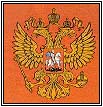
Russian 2nd Army of the West Dispatch
T
he Russian army continues to expand rapidly with 12 new recruits since August. In addition to the influx of new recruits, the army has undergone significant command changes. Generalmajor Gil Ocampo, the first officer to achieve that rank, stepped down as Chief of Staff to attend to his estates. A grateful Tsar awarded Generalmajor Ocampo with the Order of St. Vladimir in recognition of his service as chief of staff. Happily, Generalmajor Ocampo soon returned to active service as the first inductee of the Guard Corps. The vacant chief of staff position was assumed by Generalmajor Karl Schneider.
O
ther promotions and command reassignments include:Col. Doggett assumed command of 7th Corps
Captain Hummel to Major
Colonel Schneider to Generalmajor
Major Becker to Lt. Col.
Lt. Col. Becker assumed command of the 12th Infantry Division shortly after his promotion.
Lt. Lopez to Major
Major Hummel to Lt. Col.
Lt. Col. Hummel subsequently assumed command of the 27th Division.
Captain Yrureta to Col.
After his promotion, Col. Yrureta assumed command of the 4th Cavalry Division.
Lt. Believ to Major
Lt. Col. Cartridge to Col.
Lt. Sutton to Captain
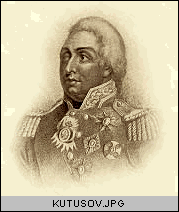
Russian officers continued to enjoy success on the battlefield, logging seven victories in the last two months. Col. Yrureta became the first Russian officer to be awarded the coveted Order of Alexander Nevsky. In a bloody contest (Kutusov Turns to Fight), Col. Yrureta bagged 57,050 infantry, 16,400 cavalry, 285 guns and 78 leaders, including 26 Colonels, 31 Generals of Brigade, 12 Generals of Division, 8 Generalmajors and 1 Generalleutenant. Col. Yrureta followed up on this battle in another spectacular victory in which he destroyed 67,225 Infantry, 17,250 Cavalry, 302 guns and 124 leaders (42 Col., 46 Gen of Brig, 25 Gen of Div, 8 GM 1 Generalleutenant, Prince Eugéne de Beauharnais, and Marshal Murat) at the cost of 50, 775 Infantry, 15,875 Cavalry, 85 guns, and 52 Leaders.
Shortly afterward, Generalmajor Schneider was awarded the Order of Alexander Nevsky for a major victory in a Kutusov Turns to Fight scenario, destroying 44350 infantry, 15450 cavalry, 226 guns and 61 leaders (14 Colonels, 25 General de Brigade, 13 General de Division and 9 Generalmajors). Russian casualties were 27125 infantry, 10600 cavalry, 154 guns and 12 leaders.
Major Lopez became only the second Russian officer to be decorated with the Order of St. George for his fifth major victory.
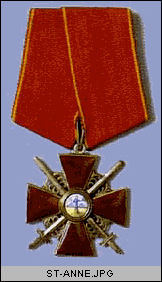
O
ther officers earning medals include:Military General Service Medal to Lt. Col. Zach Becker (1st victory in excess of 10 turns)
Military General Service Medal to Major Lopez (1st victory in excess of 10 turns)
Order of St. Anne to Col. Yrureta (1st major victory)
Army Best Shot Medal to Col. Yrureta (capture of Marshal Murat)
Army Best Shot Medal to Lt. Ward (capture of Marshal Murat)
Long Live The Tsar!
Karl Schneider
Generalmajor Karl Schneider
Chief of Staff
Second Army of the West
The Front Page | Feature Articles | Strategy and Tactics | Dispatches | On the Internet | Letters to the Editor
British Army | La Grande Army | Prussian Army | Russian Army

Promotions
George
by the Grace of God, of the United Kingdom of Great Britain and Ireland and of the British Dominions beyond the Seas, King, Defender of the Faith, has recognized and ordered the promotions of the following officers for their services with his Majesty's forces during the current campaigns against the French:Captain James Munro to Major
Captain Richard Holland to Major
Major James Alexander to Lt. Colonel
(say what?)Captain Douglas McKenzie to Major
Lt. Sergi Maymi to Captain
His Majesty has also decreed that the following awards be conferred for service with the British Forces during the current campaigns against the French:
To Lt. C. Cook, the
Military General Service Medal for his first victory over the French forces.To Lt. Col. James Alexander, the
Military General Service Medal for his first victory and his early reporting of results and constant taunting of the French.To Lt. Colonel M. O'Reilly, a Bar to his
Military General Service Medal for his second victory.To General Rodrigo Leon, a Bar to his
Military General Service Medal for exemplary conduct in beating the King's foes.To Major Douglas McKenzie, the
Waterloo Medal and bar to his Military General Service Medal for his continued success in battle against the French.
The
Long Service and Good Conduct Medal is awarded to:General Rodrigo Leon for continued service training junior officers.
Lt. Colonel Michael O'Reilly for continued service training junior officers.
Pat Dobson for continued service running the 3rd Divisional journal.
Lt. Ken Jones for his contributions to the NWC newsletter and dispatches.
Colonel Andy Smith for continued service in training junior officers.
The
Army Best Shot Award to:Major Richard Holland for his services to the King and continued early reporting of actions and constant taunting of the French.
Lt. Colonel James Alexander for exemplary conduct on the field of battle as testified to in a dispatch from the French Commander.
In Forwarding these Decorations, I am commanded by the King to assure you of His Majesty's high appreciation of the services rendered.
I am Sirs,
Your obedient Servant,
Paul Harris
P Harris Brigadier General

L'Armee du Nord
I Corps Promotions
:Fabio Fogato - Chef d'Escadron
Chris Sloan - Colonel
Ian Weightman - Chef de Bn
.
I Corps Awards:
Gen. Bardon - Legion of Honor
Col. Sloan - Order of Iron Crown
II Corps Promotions:
To the rank of Capitaine: S. Dodson, D. Dassler, D. Hocking, S. MacPhee.
To the rank of Colonel: E. Einarsson IV and C. Jensen
II Corps Awards:
The following officers awarded the Medaille Militaire for major victories over the Allies.
Capt. S. Dodson, Capt. R. Forster, Capt. D. Dassler, Capt. D. Hocking
Other Awards:
Col. Jensen awarded the Valour Cross & Order of the Iron Crown
Capt. S. MacPhee awarded the Order of the Iron Crown
In recognition of his 5 major victories, Col. Jensen has also been honored with a command in the Grenadier Brigade of the Old Guard of the
Emperor's Imperial Guard, and granted the title of Count of Suchet.
III Corps Awards:
Marshal Barbier - Laurel for Iron Crown
Army Awards:
L'Empereur graciously awarded your correspondent the Order of the Iron Crown and promoted him to Gen. de Division.
Your Humble Servant,
Gen. M. Francisco Palomo
Gen. de Dv. M. Francisco Palomo
Count de Massena
CoA, and
L'Armee du Rhine
Promotions:
The following Officers have been promoted to the following ranks and shall enjoy all privilages and pay associated with their new rank.
The following have finished their training at EdM, and hereby been promoted to Lieutenant
.
John Fisher, Barry Maunsell, Aaron Sibley, Paul Synnott, Nano Capfer, Travis Senne, Gerry 'Shaughnessy, Ernest Barbour, Pablo E. Velo, Domomic Bovo, John Neblo, Mark Collino, Leigh Monk, Tony Bovo, Stefano Borri, Steve Malbaski and Jeff Moore.
Medals & Honours:-
It is with great pride the 'Medaille Militaire' is awarded to the following Officers for their first victory.
Lt Col. Bernard Moulin for his actions against an Anglo-Allied lead force.
Lt Col. Barry Maunsell for his actions against an Anglo-Allied lead force.
Major Steve Goodwin for his actions against an Anglo-Allied lead force.
Capt. Travis Senne for his actions against an Anglo-Allied lead force.
Lt. Ernest Barbour for his actions against an Anglo-Allied lead force.
Lt. Michael J. Ellwood for his actions against an Anglo-Allied lead force.
Lt. Tony Bovo for his actions against a Prussian lead force.
Lt. Giovanni Boffi for his actions against a Russian lead force.
On the recommendation of their Corps Commander, the following Officers have received awards. These Officers continue to show, willingness, commitment and service over and above the call of duty to their Corps, Commander and fellow Officers. Their active status do them credit, as well as being a great asset to those around them.
I have great pleasure in awarding the following Officers the
'Order of the Iron Crown'.V Corps
Ecole de Mars
I have great pleasure in awarding the following Officer the 'Legion of Honour' .
L'Armee du Rhin Commanders Special Recognition Award & Mention in Despatches:-
Every now and then we see a character rise from the depths of nowhere. Recently I had the pleasure to promote a young Sous-Lt after completion of His training at the Ecole. However not satisfied was this young Sous to graduate before engaging the enemy, nor could He pick a brawl with an Allied officer of equal rank! No this young Man decides to pick a fight with 4 of the most feared and highest ranking Officers the British army has to offer. Luckily for Him Col Hamilton was at the Tavern to stop this Sous before the Gauntlet was picked up. Whilst I can not have Sous-Lt's engaging in combat before graduating, I enjoyed this mans whit and daring! and on this occasion no harm was done. For shear tenacity and pluck I recognize
Lt. Domonic Bovo and award him a mention in dispatches and with it 5 points.
The following Officers have in the last months dedicated time, effort and above all 'Loyalty' to L Armee du Rhin. In their separate capacities I have found each of them to be utterly devoted to the forward progression of this armee and the club. Like the Shivelys, Adams, Andreassons, and Gregorries before them,
Colonels Hamilton & Frederiksen have put personnel gaming time to one side in order to first establish a working system within their respective Corps/Duties. I think all will agree that the fruits of their labour is now very apparent.I can not start to thank you both, but am delighted to award the following Officers:-
The ' Legion of Honour'
.
Respectfully Submitted,
Jon Brewitt
General Jon Brewitt
Commanding
L'Armee du Rhine

For Seventh "Allied" Victory
For Fourth "Allied" Victory
For First Victory Over French

SEE DISPATCH SECTION
The Front Page | Feature Articles | Strategy and Tactics | Dispatches | Front and Center | Letters to the Editor
There is a heck of a lot of stuff our there on the web for those interested in Napoleon and the Napoleonic Wars. More than we can possibly put in the newsletter. A few of the more interesting sites that Chris and I have come across are described below. We encourage members to share their favorite sites as well (just drop one of us a line). KJ
The War Times Journal
. (http://www.wtj.com/) This site has some excellent stuff all relating to military history and military science. Its boasts archival material (old letters, orders, newspapers, etc), interesting articles, a war history section, information on wargames, a store, a portal to other sites on the web, and is even equipped with a search engine. The war series section has a good collection of materials relating to both the Napoleonic Wars and the American Civil War, among others.The Regency Collection
. (http://homepages.ihug.co.nz/~awoodley/Regency.html) The Regency period, as you all know, lasted from 1810 to 1820 when the Prince of Wales, who would later become George IV, reigned in place of his father, George III. This time span covers most of the Napoleonic years and so, naturally, the site boasts a Military section that contains a trove of information on military campaigns, particularly those of the Peninsular War and Waterloo. Included are the writings of several diarists on their war experiences, a few autobiographies, regimental histories, and just a wealth of other stuff about the period. Really interesting.Military Heritage: The Internet Magazine
. (http://www.militaryheritage.com/home) This military magazine boasts sections on the Seven Years War, the Napoleonic War, the American Revolution, and the War of 1812. It is part of a web of sites published by The Discriminating General. The magazine has articles, eyewitness accounts, biographies, etc. The Discriminating General also produces and sells uniforms and equipment for period reenactors. A great place to pick up that heavy cavalry sword you always wanted. Check it out.Napoleon's Lost Fleet @ Discovery Channel Online
. (http://www.discovery.com/stories/history/napoleon/napoleon.html) After months of pursuit, Admiral Nelson's British fleet finally brought Napoleon's fleet to battle in Aboukir Bay off the coast of Alexandria, Egypt in 1798. This website (online companion to a television special -- available in video) chronicles the battle and the 1998 archeological expedition to the site where Napoleon's flagship, The Orient, and two sister ships lay on the bottom of the sea. A great story, then and now.1812 and Napoleonic Links.
(http://www.ddg.com/LIS/InfoDesignF96/Emin/napoleon/links.html) Not really a webpage but a page of links to quite a few other interesting sites. Surf's Up!
The Front Page | Feature Articles | Strategy and Tactics | Dispatches | Front and Center
If you have something to contribute or would like comment on any aspect of the newsletter or the NWC, then feel free to write a letter to the editor (paula.ken@erols.com) However, this newsletter reserves the right to ignore, edit, delete and/or refuse to publish any letter received if it is deemed to be inappropriate or worthless. All letters absolutely must include the name of the author and his/her e-mail address or they will not be posted. KJ
Jones, Kenneth
From:
Michael W. Gjerde [mwgjerde@qwestinternet.net]Sent: Sunday, October 31, 1999 11:37 AM
Subject: British Army joins 20th Century...a little late?
From The London Times, October 30, 1999; (I think)
Hugh McManners, Defense Correspondent
IT MAY have won the battle of Waterloo "on the playingfields of Eton", as the Duke of Wellington averred, but the British Army has finally succumbed to meritocracy. For the first time in centuries the nation's security is in the hands of top brass drawn from outside the public schools, a new survey has revealed.
A generation ago the most able and intellectual generals had been educated largely at Eton, Harrow or Winchester. They dominated the inner council of the army, known as Number One Board, which in turn selected people, often from similarly privileged backgrounds, for the army's senior appointments. More than 80% of Number One Board had attended the top public schools.
Now not a single old Etonian sits on the board and most lower-rank generals did not go to public school. "It's absolutely disgraceful," one old Etonian brigadier said last week. "You'd have thought the board would have co-opted an Etonian, if only for appearances' sake."
The findings come from an analysis of meritocracy on the march conducted by Professor Reginald von Zugbach, a German academic at Paisley University. "Senior army officers today are from the same types of background as the leaders of other professions," he said. "When you compare them with the church and the law - the other traditional occupations for the gentry - the army is now much less elite."
In 1974, 58% of generals and field marshals were from one of the leading public schools; now only 33% are. Traditionalists may be aghast that today a mere 6% of major-generals come from the top public schools. Major-General Kevin O'Donoghue (Eastbourne College and Manchester University) said: "Old school tie was a means of promotion, but that has changed in the past 20 years. Now you don't get promoted because of who you are but because of your ability."
Sir Michael Rose (Cheltenham College and Oxford), a former Army Board member (the service's senior decision-making body), and adjutant-general responsible for all personnel matters in the army, agreed. "It's not a deliberate act by the army to select people from different types of school, but it is nevertheless a conscious change," he said. "Today's officers come from a much wider- based educational system in which far more people go to university than before."
Not since the New Model Army of Oliver Cromwell, a country squire, have officers from such backgrounds wielded so much power. Cromwell's egalitarianism, however, was short-lived. With the restoration of the monarchy, the social elite once again came to dominate the army. The television comedy series Blackadder reflected the divide in the condescending character of Captain Blackadder and his long-suffering aide, Baldrick.
For Major Eric Joyce (army ranks and Aberdeen University) prejudice still permeated the service when two years ago he wrote a pamphlet accusing the army of being "steeped in snobbery". General Sir Michael Walker (Milton School in Bulawayo, Zimbabwe, no university), commander in chief of land forces, referred the matter to the Army Board and Joyce was eventually told to resign. The army's rebuttal of Joyce's attack is now vindicated by von Zugbach's findings.
"It all reflects a general attitude in British society," said Cary Cooper, professor of organisational psychology at the University of Manchester. "The army is becoming more like a business where you need skilled people to manage finances, human resources and technology rather than people who just come from the traditional public school background."
A rearguard action, however, is being fought by the so-called "smart" regiments such as the Guards, Royal Green Jackets and the cavalry, which see themselves as superior to the ordinary "fish and chip" regiments.
One senior cavalry officer admitted last week that the chances of a boy not from a public school being accepted by his regiment's officer ranks are still slim. "We're looking for people who fit in with those already in the regiment," he said. "We're always well recruited from the public schools. Out of about 40 officers there are always two or three old Etonians and a couple from grammar schools. One or two each year, usually the grammar school types, become unhappy because they don't fit in."
Public school, of course, does confer some useful skills. General Sir Peter de la Billiegravere was sneaking out through windows and over walls under the cover of darkness long before he joined the SAS. As a boarder at Harrow he frequently made night-time sorties to the bright lights of central London.
Jones, Kenneth
From: juan rios <rios@iedatos.es
Sent: Sunday, November 07, 1999 7:45 PM
Subject: Origin of the word "hussars"
This letter is just to add a brief explanation to a historical question I have come across when reviewing the first letter of the club. There, in the Trivia Contest section, a question was asked about the origin of the word "Hussar", and the winner (I can´t remember his name, sorry), gave an explanation about the 15th century light cavalry units. That´s right, but about the origin of the word itself, I believe that it comes from two Hungarian (many of the costumes, words and even dresses of the hussars come from that country) words: 'husz' -- meaning "one per hundred", and 'ar' -- meaning "rent". You see, back then every landowner was forced to contribute a light rider and his equipment to his lord for each hundred people living in his (the landowner's) lands. That´s why those riders were known as hussars..
I beg you to publish this comment please.
Regards,
Major Juan A. Ríos
3éme Div de Cav Lourde Commander
Armée du Nord
Jones, Kenneth
From:
Jones, KennethSent: Wednesday, November 17, 1999 11:05 AM
Subject: All's Fair in Love and War
Dear Readers:
After watching me spend hours playing these Napoleonic games and conversing with my fellow officers in the Rhine Tavern and the Allied officer's mess, my Lady tried to persuade me that this activity was sheer folly. "The war is long over," she declared. "Napoleon is dead, and all this role-playing and wargaming is lunacy." When I expressed disbelief at the death of the Emperor and demanded proof, she undertook a trip to Paris to obtain evidence of his demise. As she handed me the evidence upon her return, I let out a deep sigh of relief. "The French officer's tomb in this picture," I explained, "is NOT that of Napoleon Boneparte. HE LIVES! I exclaimed. VIVE L'EMPEROR! Did I say that?
But, as the saying goes, "All's fair in love and war". And so, per her request, I have attached a picture of Mademoiselle Jones, my Lady and Confidante, posing in front of the tomb of the great French Marshall Foch (click here).
K. Jones
Attachment
The Front Page | Feature Articles | Strategy and Tactics | Dispatches | Front and Center | On the Internet
THE END

photo by: Jack Sheehand
Les Invalides
The Hôtel des Invalides was built in 1670 by Loius XIV for disabled soldiers. Finished by Jules Hardouin-Mansart, the chapel of Saint-Louis houses the tomb of Napoleon I. The Army Museum and the Plans-Reliefs Museum are part of the site.